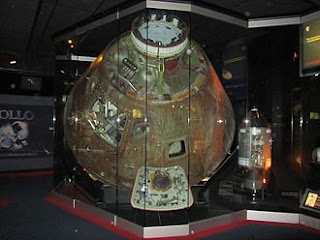A fuel cell is a galvanic cell in which the reactants are fed in a constant stream. This essentially creates a battery that never runs out (as long as the fuel supply is not interrupted). There are a number of types of fuel cells and this is an area of active research, but to make the idea clear, we’ll look at a particular type of fuel cell - a Hydrogen Cell.
The Hydrogen Fuel Cell
Although the hydrogen fuel cell is the most commonly used fuel cell now, there are a number of ways that these can be built and used. We’ll look at an older type of fuel cell that uses an alkaline (basic) electrolyte solution.
The Structure
The fuel cell consists of a chamber into which the fuel (hydrogen) is pumped, a chamber into which oxygen is pumped, and two porous electrodes that surround a basic solution, like \(NaOH_{(aq)}\).
The Reactions
On the hydrogen side of the cell, the hydrogen loses electrons to become \(H^{+1}\) ions which combine with hydroxide ions that have moved through the electrode. The \(H^{+1}\) ions and the hydroxide then form water. Some of those water molecules will move through the electrode into the middle.
\(H_{2~(g)} + 2~OH^{-1}_{(aq)} \rightarrow 2~H_2O_{(l)} + 2~e^{-1}\)
On the oxygen side, the \(O_2\) takes 4 electrons and reacts with 2 water molecules that have moved through the electrode to make 4 hydroxide ions which will then move back into the middle.
\(O_{2~(g)} + 4~e^{-1} + 2~H_2O_{(l)} \rightarrow 4~OH^{-1}_{(aq)}\)
Remember that when we balance redox reactions, we need to match the number of electrons in the oxidation and reduction half-reactions. In this case, we need to double the hydrogen reaction. That gives us:
\(2~H_{2~(g)} + 4~OH^{-1}_{(aq)} \rightarrow 4~H_2O_{(l)} + 4~e^{-1}\)
\(O_{2~(g)} + 4~e^{-1} + 2~H_2O_{(l)} \rightarrow 4~OH^{-1}_{(aq)}\)
Adding those two together gives:
\(2~H_{2~(g)} + 4~OH^{-1}_{(aq)} + O_{2~(g)} + 4~e^{-1} + 2~H_2O_{(l)} \rightarrow 4~H_2O_{(l)} + 4~e^{-1} + 4~OH^{-1}_{(aq)}\)
then, cancelling out the species that appear on both sides of the equation, we get this:
\(2~H_{2~(g)} + O_{2~(g)} \rightarrow 2~H_2O_{(l)} \)
In simple terms, our cell is burning water, but doing so electrically.
A Note From History
You probably know that the Apollo 11 mission landed two men on the moon. What you may not know is that Apollo 12 also landed on the moon as did Apollo missions 14-17. The question then becomes, what about Apollo 13?
Apollo 13 was intended to land on the moon as the others did. However, about half-way to the moon, an oxygen tank exploded. The moon was no longer a viable option and it was not clear up until the moment the command module landed in the Pacific Ocean that the crew would survive. The mission was called a “successful failure”, in that they did not land on the moon, but all three astronauts aboard made it back to earth alive and well.
What is noteworthy about Apollo 13, from a chemistry perspective, is that the danger to the crew from a lack of oxygen was not biological. They had a separate supply of oxygen for breathing. The oxygen that was lost was there to run the hydrogen fuel cells needed for all of the electrical systems. The crew was forced to shut down the command module and live for days in the much smaller lunar module, which ran on more traditional batteries.





No comments:
Post a Comment